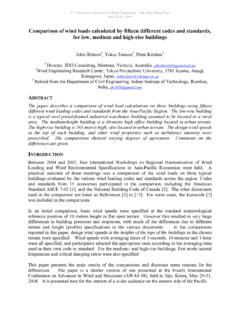Transcription of Environmental Code of Practice for Dredging and …
1 Environmental code of Practice for Dredging and dredged material management 101 Environmental code of Practice for Dredging and dredged material management August 2016 Environmental code of Practice for Dredging and dredged material management 102 Cover photo top: Courtesy of Fremantle Ports. Cover photo bottom: Courtesy of Pilbara Ports Authority (Dampier). Environmental code of Practice for Dredging and dredged material management 1 ADOPTION OF THE code OF Practice Ports australia has developed this code of Practice in consultation with members, port customers, regulators and associated industry representatives ( Dredging contractors).
2 The code was endorsed by the Ports australia Board at its meeting on 8 July 2016. Through this code of Practice , Ports australia s members have endorsed the principles contained in this document and are committed to conducting activities consistent with the code when planning and undertaking Dredging australia also invites other stakeholders (for example other port users or customers, governments, Dredging contractors) to also demonstrate the same level of Environmental responsibility and management in undertaking or supporting Dredging australia has used current relevant information from australia and internationally to support the development of this code of Practice .
3 This included: examples of similar industry codes and guidelines; state/territory policies and guidelines; published papers and research activities relating to minimising Dredging impacts; and best Practice methodologies, tools, systems code of Practice for Dredging and dredged material management 2 Photo courtesy of Dalrymple Bay Coal code of Practice for Dredging and dredged material management 3 CONTENTS PURPOSE ..5 code OF Practice PRINCIPLES ..7 PORTS AND Dredging ..11 THE PRINCIPLES EXPLAINED.
4 15 Environmental Awareness ..15 Environmental Risk Assessment and management ..15 Avoidance, Mitigation and Offsets ..17 dredged material Relocation ..18 Dredging Operations ..20 Monitoring ..20 Consultation and Communication ..21 Compliance ..21 Transparency and Accountability ..22 Research and Innovation ..22 REVIEW AND REPORTING ..23 GLOSSARY ..25 NOTES ..26 Ports australia 2016. All rights reserved. No use of this work, which is within the exclusive right of the copyright owner, may be thanks to: Environmental code of Practice for Dredging and dredged material management 4 Photo courtesy of Port code of Practice for Dredging and dredged material management 5As an island nation dependent on maritime trade, australia s ports are a vital link between Australian communities and industry and overseas markets and commodities.
5 The National Ports Strategy notes that: As a maritime nation, australia s ports are an important gateway for goods and for our defence. Consequently, ports and associated infrastructure are of the utmost economic and social importance to australia .1 Ensuring we have ports that are efficient, safe and with adequate capacity is the joint responsibility of governments (at all levels), port managers, industry and other stakeholders. Development and maintenance of appropriate infrastructure that can facilitate trade is a primary element of port planning and operations.
6 The establishment and ongoing management of waterside infrastructure, including shipping channels, ship berths and swing basins, is as important as the development and maintenance of landside infrastructure such as roads, railways and port majority of australia s exports and imports travel through our ports. In 2012 13, sea freight accounted for of australia s total merchandise exports and of Trade volumes PURPOSE through Australian ports are growing and this growth is expected to This will involve more ships visiting our ports and also larger ships as the global shipping industry is continually looking to improve the economies of scale of its In order to remain competitive with international trade, ports need to conduct regular maintenance Dredging to keep shipping channels and berths open and safe.
7 Periodically ports also need to enhance or increase infrastructure capacity through capital Dredging programs. The Australian port industry has been delivering successful and sustainable Dredging programs for decades and, in many ports, for more than a century. Public interest in Dredging has grown in step with a significant shift towards greater Environmental awareness. Despite Australian ports having an excellent track record in undertaking sustainable Dredging programs5, Dredging and dredged material relocation in australia has in recent years been subject to high levels of political, media and public code of Practice for Dredging and dredged material management 6 Photo courtesy of Gladstone code of Practice for Dredging and dredged material management 7 Leading Practice management of Environmental risks associated with Dredging is well defined and recognised internationally and nationally.
8 This code of Practice sets out a series of Environmental principles that Australian ports follow when undertaking Dredging and when reusing, relocating or disposing of dredged material . australia has an excellent Environmental record in the successful implementation of Dredging Port Managers invest considerable time and funding into understanding and monitoring the environment within and surrounding their operations. The monitoring and research work undertaken by ports forms a significant contribution to the existing scientific knowledge on coastal environments in In australia Dredging and dredged material relocation is closely regulated and monitored.
9 australia is a signatory to global conventions (the London Convention and London Protocol) that works to prevent marine pollution by the dumping of wastes and other matter at sea. The London Protocol aims to protect and preserve the marine environment from all sources of pollution and take effective measures, according to their scientific, technical and economic capabilities, to prevent, reduce and where practicable eliminate pollution caused by dumping or incineration at sea of wastes or other matter (Article 2, London Protocol 2006). The London Protocol is given effect via the Environment Protection (Sea Dumping) Act 1981 (the Sea Dumping Act), which applies to all Australian waters.
10 All at-sea placement of material is prohibited, however, permits may be issued to allow the placement of specified materials. Clean dredged material may be permitted for at-sea placement under certain strict States and the Northern Territory also have independent governance and regulations relating to Dredging and placement of dredged laws and conventions are designed to make sure that Dredging activities are properly assessed and managed and that unacceptable impacts to our natural environment are Sustainable Development The National Strategy for Ecologically Sustainable Development, endorsed by all Australian jurisdictions in 1992.





